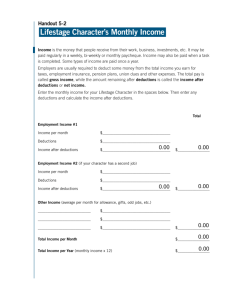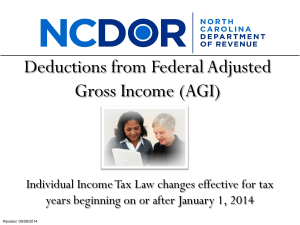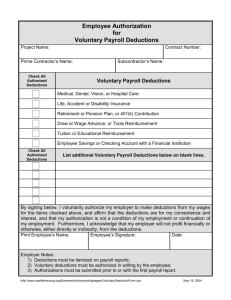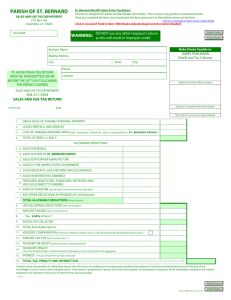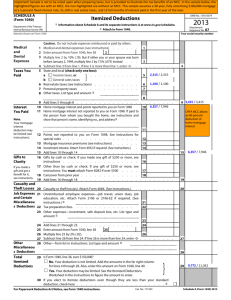Itemized Deductions
advertisement
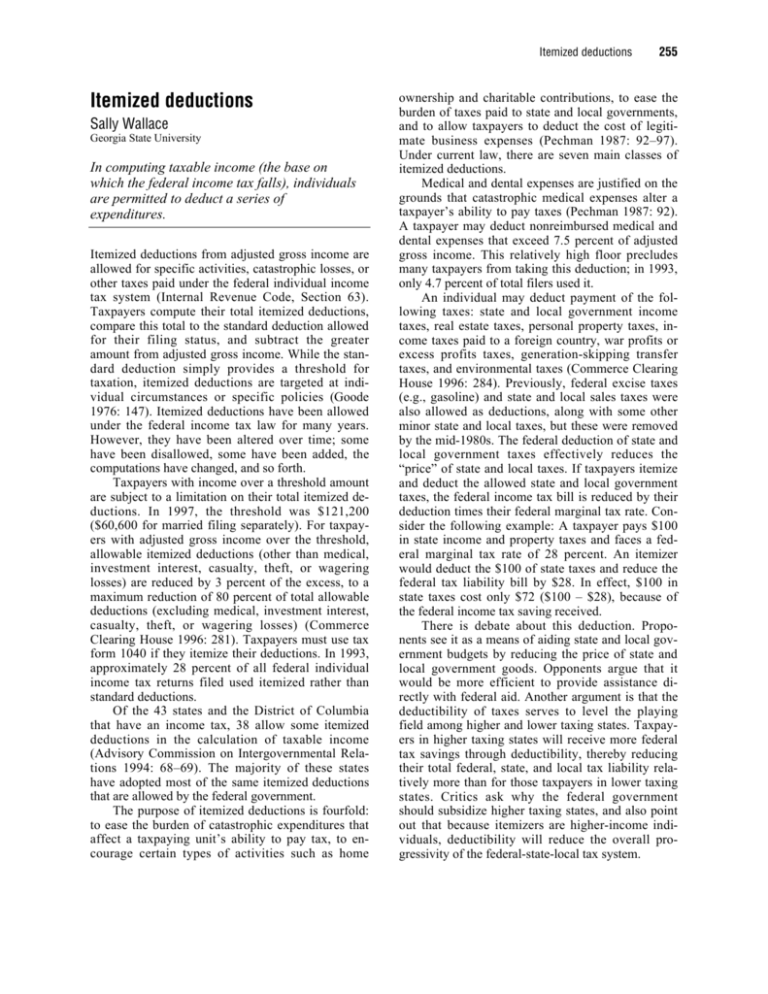
Itemized deductions Itemized deductions Sally Wallace Georgia State University In computing taxable income (the base on which the federal income tax falls), individuals are permitted to deduct a series of expenditures. Itemized deductions from adjusted gross income are allowed for specific activities, catastrophic losses, or other taxes paid under the federal individual income tax system (Internal Revenue Code, Section 63). Taxpayers compute their total itemized deductions, compare this total to the standard deduction allowed for their filing status, and subtract the greater amount from adjusted gross income. While the standard deduction simply provides a threshold for taxation, itemized deductions are targeted at individual circumstances or specific policies (Goode 1976: 147). Itemized deductions have been allowed under the federal income tax law for many years. However, they have been altered over time; some have been disallowed, some have been added, the computations have changed, and so forth. Taxpayers with income over a threshold amount are subject to a limitation on their total itemized deductions. In 1997, the threshold was $121,200 ($60,600 for married filing separately). For taxpayers with adjusted gross income over the threshold, allowable itemized deductions (other than medical, investment interest, casualty, theft, or wagering losses) are reduced by 3 percent of the excess, to a maximum reduction of 80 percent of total allowable deductions (excluding medical, investment interest, casualty, theft, or wagering losses) (Commerce Clearing House 1996: 281). Taxpayers must use tax form 1040 if they itemize their deductions. In 1993, approximately 28 percent of all federal individual income tax returns filed used itemized rather than standard deductions. Of the 43 states and the District of Columbia that have an income tax, 38 allow some itemized deductions in the calculation of taxable income (Advisory Commission on Intergovernmental Relations 1994: 68–69). The majority of these states have adopted most of the same itemized deductions that are allowed by the federal government. The purpose of itemized deductions is fourfold: to ease the burden of catastrophic expenditures that affect a taxpaying unit’s ability to pay tax, to encourage certain types of activities such as home 255 ownership and charitable contributions, to ease the burden of taxes paid to state and local governments, and to allow taxpayers to deduct the cost of legitimate business expenses (Pechman 1987: 92–97). Under current law, there are seven main classes of itemized deductions. Medical and dental expenses are justified on the grounds that catastrophic medical expenses alter a taxpayer’s ability to pay taxes (Pechman 1987: 92). A taxpayer may deduct nonreimbursed medical and dental expenses that exceed 7.5 percent of adjusted gross income. This relatively high floor precludes many taxpayers from taking this deduction; in 1993, only 4.7 percent of total filers used it. An individual may deduct payment of the following taxes: state and local government income taxes, real estate taxes, personal property taxes, income taxes paid to a foreign country, war profits or excess profits taxes, generation-skipping transfer taxes, and environmental taxes (Commerce Clearing House 1996: 284). Previously, federal excise taxes (e.g., gasoline) and state and local sales taxes were also allowed as deductions, along with some other minor state and local taxes, but these were removed by the mid-1980s. The federal deduction of state and local government taxes effectively reduces the “price” of state and local taxes. If taxpayers itemize and deduct the allowed state and local government taxes, the federal income tax bill is reduced by their deduction times their federal marginal tax rate. Consider the following example: A taxpayer pays $100 in state income and property taxes and faces a federal marginal tax rate of 28 percent. An itemizer would deduct the $100 of state taxes and reduce the federal tax liability bill by $28. In effect, $100 in state taxes cost only $72 ($100 – $28), because of the federal income tax saving received. There is debate about this deduction. Proponents see it as a means of aiding state and local government budgets by reducing the price of state and local government goods. Opponents argue that it would be more efficient to provide assistance directly with federal aid. Another argument is that the deductibility of taxes serves to level the playing field among higher and lower taxing states. Taxpayers in higher taxing states will receive more federal tax savings through deductibility, thereby reducing their total federal, state, and local tax liability relatively more than for those taxpayers in lower taxing states. Critics ask why the federal government should subsidize higher taxing states, and also point out that because itemizers are higher-income individuals, deductibility will reduce the overall progressivity of the federal-state-local tax system. 256 Itemized deductions Mortgage interest payments and points, and investment interest expenses, are deductible subject to certain limits. Mortgage interest (up to two homes), interest on home equity loans, and interest expenses incurred for investment purposes (up to a limit equal to investment income) are deductible. Before the Tax Reform Act of 1986, consumer interest was also deductible, and the rules for investment interest deductions were generally more lenient. The deduction for investment-related interest expenses is justified as a cost incurred in doing business. Mortgage interest is less easily justified as a deduction. It probably does encourage homeownership, which may help to provide stability in the economy. However, because homeowners do not report income from their owneroccupied homes, the deduction of interest expenses would not seem justified as an expense (Pechman 1987: 94). Additionally, this deduction gives homeowners a great advantage over renters. Cash and in-kind gifts to charity are another form of itemized deductions. (Between 1982 and 1986, nonitemizers were also allowed to deduct some charitable contributions.) In general, taxpayers can deduct an amount equivalent to up to 50 percent of their adjusted gross income. A limit of 30 percent of adjusted gross income applies to gifts to some types of foundations and organizations. Because charitable contributions are deductible, the federal government in effect pays part of the individual taxpayer’s contributions. Whether or not the income tax system should support such contributions has been a matter of limited debate. Some believe that the good done by these charitable organizations is worth the federal government’s support (Pechman 1987: 94), while others believe that allowing such deductions is a violation of the separation between church and state (Rosen 1995: 376). The casualty and theft loss deduction applies only to nonbusiness property. The goal is to protect a taxpayer in the event of catastrophic loss. The deduction is limited to losses in excess of 10 percent of the taxpayer’s adjusted gross income. Job expenses and “miscellaneous itemized expenses” are a separate group of deductions, justified as expenses incurred in the production of income. Job expenses include job-related travel, union dues, job education, uniforms, and subscriptions to professional journals. Miscellaneous deductions include tax preparation fees and expenses incurred in the production or collection of taxable income such as safe deposit box rental, legal and accounting fees, and clerical help. All deductions reported in this group are subject to a 2 percent floor—the taxpayer can deduct only those expenses that exceed 2 percent of adjusted gross income. Certain other miscellaneous deductions that may be itemized include moving expenses incurred in an earlier period, gambling losses that offset gambling winnings, federal estate tax on income in respect of a decedent (income received but which was also included in the valuation of a decedent’s estate for estate tax purposes), and impairmentrelated work expenses of a disabled person (Commerce Clearing House 1996: 280). These deductions are not subject to any floor. The data in table 1 summarize the use of itemized deductions for tax year 1993. This information shows that itemized deductions have a significant impact on federal individual income tax revenue. In fact, the tax expenditure estimate of the main itemized deductions for 1996 is well over $100 billion— almost 17 percent of expected federal individual income tax revenue for 1996. TABLE 1 Summary of Itemized Deductions, 1993 Total Itemized Deductions after Limitation Medical and Dental Expenses Deduction Taxes Paid Deduction Interest Paid Deduction Contributions Deduction Moving Expense Deduction Net Miscellaneous Deductions after Limitation Other Miscellaneous Deductions Total Returns Total Adjusted Gross Income Reported Source: Internal Revenue Service (1995). Notes: Total deductions are after limitation. Number of Returns Amount ($ millions) 32,694,192 5,408,223 32,155,955 27,359,989 29,717,271 804,919 7,717,250 729,192 114,626,932 $ 480,356 25,932 167,882 194,976 67,166 3,897 27,877 2,718 $3,724,124 Itemized deductions Additional readings Advisory Commission on Intergovernmental Relations. Significant Features of Fiscal Federalism. Washington, D.C.: Advisory Commission on Intergovernmental Relations, 1994. Commerce Clearing House. 1996 U.S. Master Tax Guide. Chicago, 1996. Goode, Richard. Individual Income Taxation. Washington, D.C.: The Brookings Institution, 1976. 257 Internal Revenue Service, Statistics of Income Division. SOI Bulletin (Spring 1995): 21–27. Pechman, Joseph A. Federal Tax Policy. Washington, D.C.: The Brookings Institution, 1987. Rosen, Harvey S. Public Finance. Chicago: Irwin, 1995. Cross references: adjusted gross income; income tax, federal
